The itCraft Series: Product/Market Fit. Part 1: Product

Jakub Oleksy

Alexa Trachim
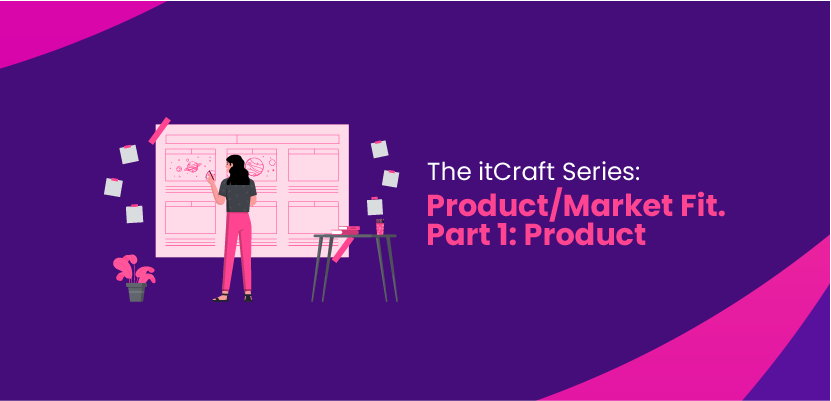
Welcome to another episode of our series about product/market fit. After our short introduction article, you already know what it is all about. If you didn’t read it yet, we encourage you to check it out. It explains why we’ve created this series and offers a short course on designing market research. Let’s get down to business with episode number one, which is dedicated to the product.
Table of content
1. What is the product?2. The Product Lifecycle
3. The Product Diffusion Curve
4. Building products using different methods
5. Building products the right way
6. Promoting the product
7. Summary
We will define the product, talk about its lifecycle, and answer the question that bothers everyone: how to build a product that will achieve success? Also, we will discuss some different approaches and methodologies used to create spectacular products.
What is the product?
A product is something that a company sells. It can be a physical item, a digital item, or a service offered to customers. There’s always a specific price we have to pay to have the product made, and in the end, it has a particular cost to be purchased.
What’s interesting about all kinds of products is that they have their own lifecycles. Think about advertisements. Some products are promoted to inform people there’s a new formula, new flavor or new packaging. Still, there are thousands of products out there, waiting to be bought and without any marketing whatsoever. That’s because each product is on a different stage of its lifecycle. It’s the first subject we will deliberate on in this article.
The Product Lifecycle
Products mature just like people. Within time, they go through various phases of maturity. If we want to keep the product on the market, at some point, we will have to invest in its makeover, add some budget for advertising campaigns or do something else to catch the attention of the customer once again. But before that, let’s see what the stages of the product lifecycle are. We have:
- Introduction
- Growth
- Maturity
- Decline
Quite self-explanatory and straightforward. We really have to consider here the amount of money we need to spend to gain profit from the product. In the beginning, you usually have to invest more, and the revenue might not even happen for some time. However, effective marketing can increase it in the growth and maturity phases.
Marketing activities throughout the product lifecycle
The main point here is to choose promotional ideas that are suitable for the phase your product is currently in. For example, during the introduction stage, you need to raise awareness about your product and the brand. That’s when early adopters are your most crucial clients because these are people that want to try something new and be the first ones to know about the novelty you prepared. Now you also have to decide if you’re going to go for a premium price to restore funds invested in development or instead offer a lower price that will cause widespread adoption.
As for the growth stage, this is the moment when you want to expand your target groups. For example, you might introduce another variant of the product to a new demographic segment of your audience. There are many possibilities, but the main goal here is to grow.
When the product enters the maturity stage, the revenue should be already significant. Right now, the marketing activities are slowing down. Your main goal is to keep the product visible on the market and better than the competition. And when the decline stage starts, the product doesn’t have to be promoted at all. A small group of people will buy it anyway based on its reputation.
If the cost of making the product is higher than the profit it provides, it’s time to take it off the market. It’s better to spend time developing a new, exciting product than putting effort into something that doesn’t really provide for the company anymore.
The Product Diffusion Curve
Now you know the phases your product will go through when it hits the market. Next step: taking a closer look at the customers. The diffusion curve shows how quickly the people from your target audience adopt new products. Finding that out will help you determine where to focus your marketing activities.
Think about your product. Which stage of the lifecycle it’s going through? You should promote it accordingly among the group that will most likely buy it.
Here are the five customer groups we can distinguish:
- Innovators – willing to take a risk, don’t worry too much about the product’s success. Usually 2.5% of the diffusion curve.
- Early adopters – they listen to innovators and want to check new solutions quickly. Approximately 13.5%.
- Early majority – as 34% of the group, usually they accept the product after it is proven by early adopters. They read reviews and opinions before they purchase.
- Late majority – also 34%, they will buy products only when they become mainstream.
- Laggards – they won’t buy new products unless there is no traditional alternative. 16% of the consumer population.
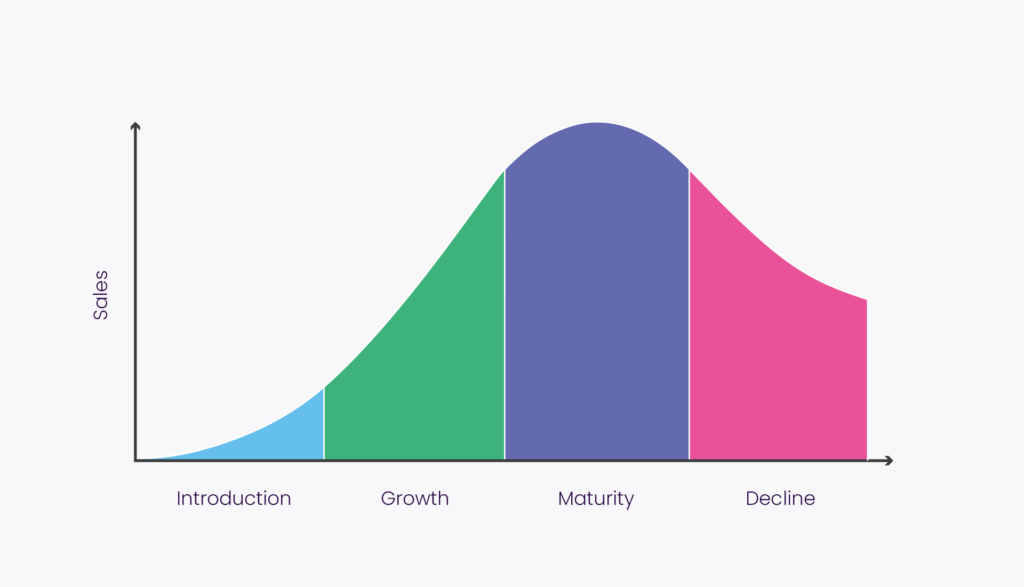
Of course, the numbers might differ a bit for your brand, but the conclusion is simple. For example, if your product is at the introduction stage, you should focus your marketing around innovators and early adopters. The advertising will be completely different from the maturity phase when your primary concern should be the late majority. Remember that one message is not enough to impress and convince all mentioned groups to buy your product. Always place it in context and act accordingly.
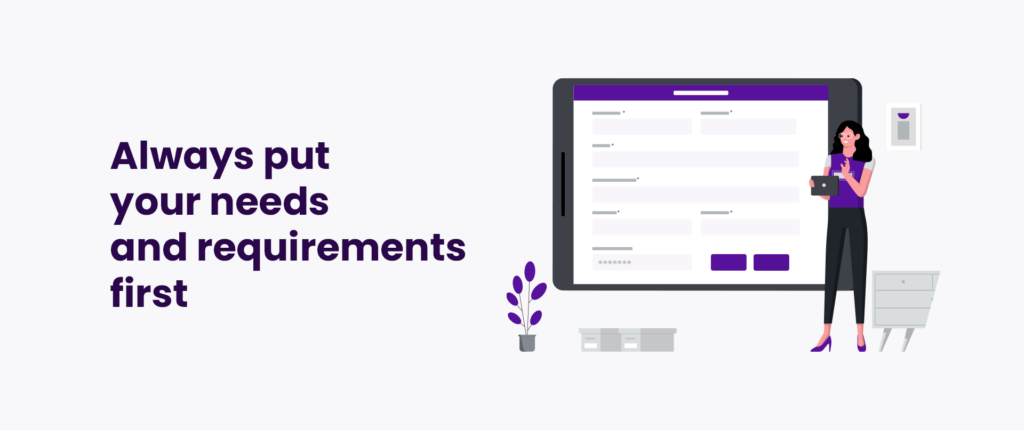
Building products using different methods
Now let’s talk more about the process. There are several approaches to creating products that will catch the audience’s attention, bring revenue to the company and achieve success in their niche. We will talk about some of them so you can pick your favorite or use principles from more than one. Always put your needs and requirements first. Then you will build an excellent product that meets the values of your customers and your company as well.
Design Thinking
Usually, we associate the word “design” with the way things look. However, this method is focused on functionality. It emphasizes user needs, thorough research, and constant evaluation to build products that slay the competition and stand out from other proposals on the market.
There are six steps to implement when working with design thinking methodology:
- Doing detailed research on end-users, with all the aspects like practicality, emotional impact and technicalities.
- Determining the problem you want to solve with your product.
- Brainstorming with people from various teams to get broad insight.
- Developing several prototypes in different forms – storyboards, wireframes, drawings, etc.
- Testing the idea and the product from the earliest stage possible.
- Creating an efficient business strategy to release and promote the product.
You don’t have to follow these steps in this particular order. If you have a sudden discovery and want to explore something more to find out if it can apply to your project, you should go for it. The design thinking method is often described with three words: “Understand – Explore – Materialize”. That’s because it clearly suggests getting to know the customer, learning about different solutions to solve their problem, and then acting on our findings to build the best possible product.
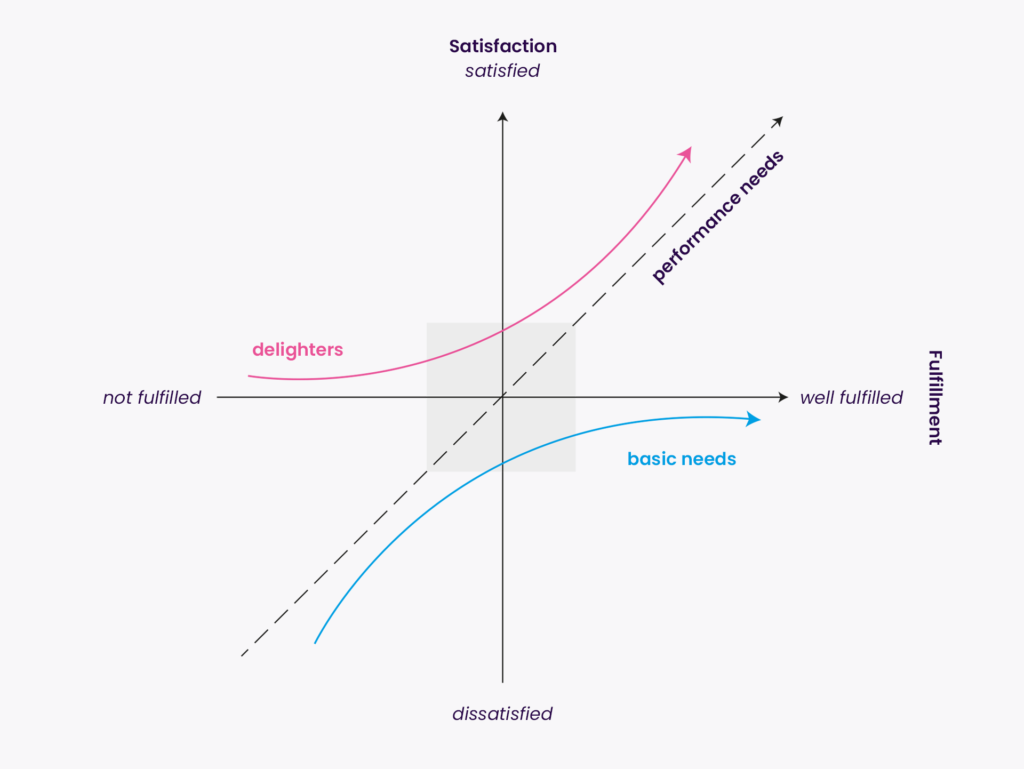
Kano Model Analysis
This Japanese technique is beneficial when you don’t know which features are crucial for your product and which ones should be done later or discarded. You might think that every functionality is important or that your customers desire as many as possible, but it’s not true. Too many might be overwhelming, while not enough will not satisfy the user and probably also won’t solve their problem. That’s why you have to know precisely which features are essential for your product’s success.
The Kano model also takes customers’ emotions into consideration. This approach suggests that sometimes a less expensive functionality that will be attractive to a customer is a much better choice than a huge investment that will not impress the audience.
There are three types of features (attributes) in the Kano model:
- Basics (threshold attributes) – things that are expected from a product. For example, a car should have seatbelts and breaks.
- Satisfiers (performance attributes) – things that are not necessary but are nice to have. They increase the customer’s satisfaction when using a product. Free Wi-Fi in a hotel room can be an example.
- Delighters (excitement attributes) – things that surprise the customer and make your product stand out from the competition. The customer doesn’t expect them, but they impress them when they occur. All complimentary things, like chocolates or cookies added to our coffee order, are included in this group.
The model above shows how each attribute influences customer satisfaction. If you don’t provide the basics, the satisfaction will decrease drastically. Delighters sometimes don’t even have to be implemented perfectly to charm the customer. As for satisfiers, they are usually the main point of competition between brands.
The Five Product Levels
Every project has essentially one goal: to meet customer expectations. Determining what they are is the key to success. If you want your product to have a competitive advantage, you can go beyond the basic expectations to make the end-user in love with what you have to offer. This approach was first described by marketing experts Kotler and Keller in 2003. They’ve claimed there are five product levels, and each allows the brand to add more value for the customer to appreciate.
These levels are:
- Core benefit – the principal value the customers will get when they buy a product. For instance, if you buy a car, you want it to be able to go from one place to another.
- Basic product – you take the core benefit and transform it into an actual product. A car needs wheels, an engine, a body and other elements that make it driveable.
- Expected product – all things besides the basic features. For a car, it would be airbags, an alarm, reliability and safety.
- Augmented product – at this point, the company can add something extra to exceed customer expectations. A built-in GPS, a new set of top-tier tires and a professional audio system fall into this category.
- Potential product – this group includes features that are totally optional but convenient, and also new technological features, sometimes pioneer ones. Connecting with an app that opens the door and starts the engine is a car feature from this group.
Now, when you know all the levels, you have to understand how to utilize them to create a product loved by many. Levels one, two and three are crucial to meet the needs of your customers. If you fail at this point, no crazy features and new additions won’t satisfy them. You have to make sure the main expectations are met before you move forward.
At level four, you can give some thought to adding something special that will give your product a competitive advantage and gain appreciation from the customers. It can mean more features, but also extra services, bundles, accessories or maintenance. Think about the cost of what you want to offer and how it can profit your business.
Products from level four can actually become level three quite quickly. That’s why there’s level five, where you can plan features to add in the future. These are all innovations that can make your product relevant and unique when the market starts to change.
Building products the right way
You know now how to shape products to distinguish them from the competition and satisfy all customer expectations and desires, it’s time to create them. And you should do that efficiently to make sure you can meet the demand and gain all potential profit. There are several ways you can approach this matter. We will present you a product-process matrix that promotes productivity, standardization of tasks and teamwork.
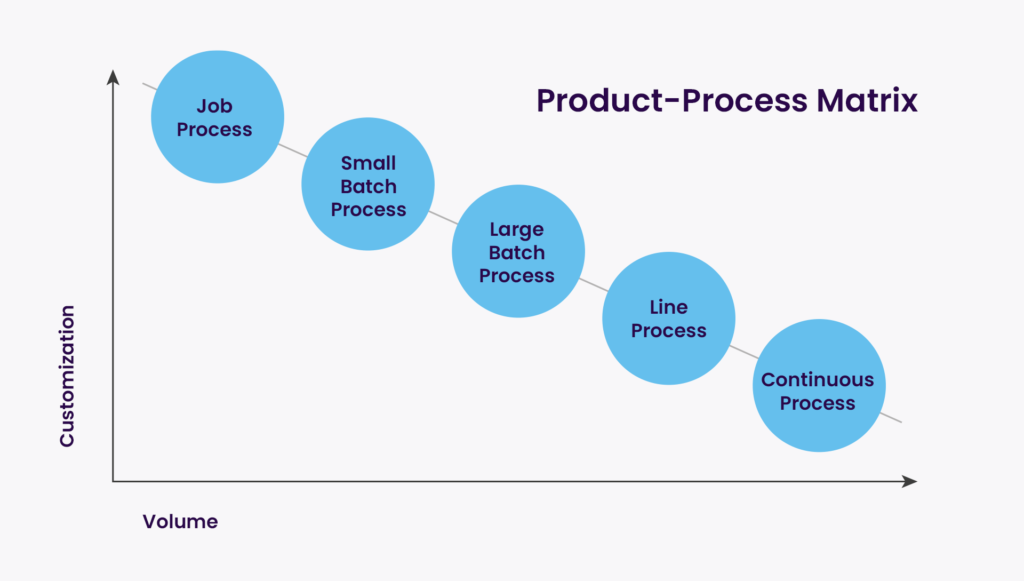
The Product-Process Matrix
This is a tool used to organize tasks and achieve better workflow as a result. It can be applied to all sorts of product-related activities. This matrix identifies what kind of approach will be the best based on the amount of product we have to prepare and the level of customization it requires. A small manufacturer that creates products for individual orders needs an entirely different process than a big company that offers hundreds of them.
So let’s take a closer look at each level of the matrix. We want to explain what they mean and what their advantages and drawbacks are.
Level 1A – Low volume, low standardization
Small businesses that create hand-made, high-quality custom products fall into this category. The process is not standardized, which can be less efficient in terms of cost and time. There is more flexibility, though, and the products are genuinely unique.
Level 2B – Multiple products, low volume
At this point, some parts of the product are made in batches. Repetition increases effectiveness, but sometimes the work can pile up if the features that are made in batches take less time than the rest of the product.
Level 3C – Few major products, high volume
It’s time to create an assembly line because right now, the volume is increasing significantly. We also need additional employees that do specific tasks. There is not much space for flexibility and advanced customization anymore. On the other hand, efficiency is excellent and easy to maintain.
Level 4D – High volume, high standardization
A typical factory-like model of work, when production doesn’t stop for one minute. It’s expensive to set up, but when it works, it’s pretty cost-efficient. Creating large volumes of products provides more significant profit, but there is no flexibility whatsoever.
Why can this matrix be helpful?
Mostly because business owners often overlook the moment when it’s time to change the way they operate. This way, they lose clients and a chance to grow their revenue. The Product-Process Matrix underlines the importance of delegating things, creating procedures, building competent teams and prioritizing parts of production that could be burdensome when done alone.
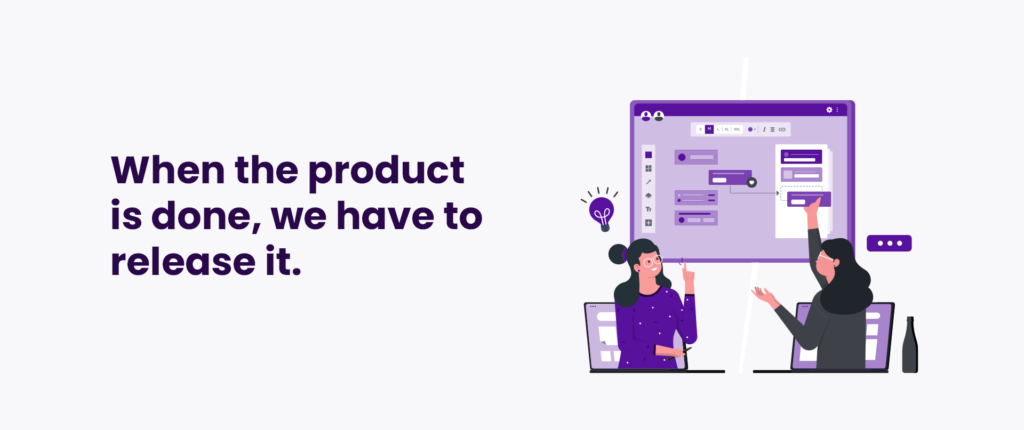
Promoting the product
Last but not least, when the product is done, we have to release it. Before that, though, it’s worth spending time strategizing marketing activities to make sure it hits the right target group and is promoted with the right message. That’s when 4Ps come in hand. We know that we mentioned a similarly-named method in our intro article, but this is slightly different. We will explain it below and show you how to use it to turn your product into success.
The 4Ps of marketing
The four Ps stand for product/service, place, price and promotion. Each of these groups has its own questions to determine the details needed for marketing to be effective. We take our product, and then we analyze it using the four Ps. This way, we can act accordingly. You should regularly revisit your marketing plan created with this method and ask the questions again to ensure everything is relevant.
So what kind of questions can you ask?
- Product/service: what do customers want from you? How will customers use it? What will be its name, color, branding? What makes it different from the competition?
- Place: where will buyers look for your product? How can you determine the proper distribution channels? Will you sell it offline, online, or both?
- Price: what is the value of your product? Will more customers buy it if you slightly lower the cost? Can you offer discounts or promos?
- Promotion: which marketing channels are the most relevant for your target audience? What time will be the best to release and promote? Should you pick a different strategy than your competitors?
These are, of course, examples, so think of all the questions you could answer regarding your product and niche. It’s a great way not only to plan marketing actions but also to evaluate an existing product and optimize promotional operations when needed. If you want to dive deeper, we recommend researching a 7P marketing mix method, which is an expanded and even more insightful 4P. It becomes an industry standard as it is more detailed and provides more data on the product we want to sell.
To sum it all up
That’s a wrap on the first part of our product-market fit series. Now you know all about the product: how to define it, build it and promote it. In the upcoming episodes, you will learn what the other parts of the formula are, their purpose and how all of them connect.
Feel free to come back to this post whenever you need it. This will be your essential guide to all kinds of products. If you have questions, you can always get in touch with our business consultants that will help you transform your project into reality with all your business goals in mind. Let’s conquer the market together!






